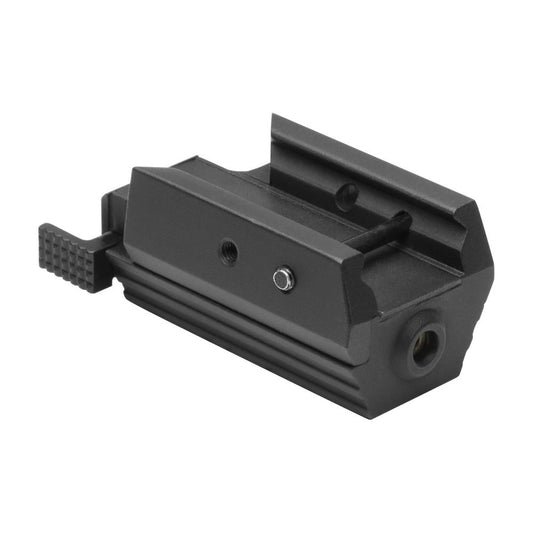

Designed for precision shooting, the NcStar Tactical Pistol Red Laser for Accessory Rail/Aluminum ensures you hit your target effectively, whether at the range or in tactical scenarios. The bright red laser, with a wavelength of 635-655nm, provides excellent visibility even in low-light conditions. This feature gives users an advantage when aiming at targets during critical moments.
Weighing only 1.3 oz and measuring 2.0" L x 1.1" W x 0.9" H, this compact laser sight is easy to handle and won't add unnecessary bulk to your firearm. Constructed from durable aluminum with a black anodized finish, it can withstand the rigors of regular use. Installation is straightforward, compatible with most weaver and Picatinny rails, allowing for quick adjustments. The side toggle on/off switch provides effortless control, enabling you to concentrate on your aim without distraction.
Features:
- PRECISE AIMING for improved accuracy during tactical shooting.
- EASY INSTALLATION with compatibility for most weaver & Picatinny rails.
- FULLY ADJUSTABLE windage and elevation settings for tailored sighting.
- COMPACT DESIGN measuring only 2.0" L x 1.1" W x 0.9" H for easy handling.
- DURABLE CONSTRUCTION featuring all-aluminum material for long-lasting use.
- POWERFUL LASER with a maximum output of <5mw for high visibility.
- USER-FRIENDLY SWITCH for quick and easy activation and deactivation.
- LIGHTWEIGHT at only 1.3 oz, ensuring it won’t add bulk to your firearm.
Technical Specifications Table
| Feature | Details |
|---|---|
| Laser Wavelength | 635-655nm |
| Maximum Output | <5mw |
| Construction | Aluminum with Black Anodized finish |
| Dimensions | 2.0" L x 1.1" W x 0.9" H |
| Weight | 1.3 oz |
| Power Source | 2 AG13 button cell batteries (included) |
What’s in the Box?
- 1 x NcStar Tactical Pistol Red Laser
- 2 x AG13 button cell batteries
- Mounting tools
Customer Reviews
"Perfect for my tactical needs. The laser is bright and easy to adjust!"
"Compact and lightweight. I barely notice it on my pistol."
"Great value! It works flawlessly in low light conditions."
FAQ
How does the NcStar Tactical Pistol Red Laser perform in various lighting conditions?
The NcStar Tactical Pistol Red Laser excels in low-light situations, ensuring you can spot your target clearly whether you're at the range during dusk or engaged in nighttime tactical activities. Its bright red laser remains visible in various lighting conditions, making it an excellent choice for serious shooters.
Is it easy to maintain the NcStar Tactical Pistol Red Laser?
Yes, maintenance is straightforward. Given its robust aluminum construction, occasional cleaning with a soft cloth is usually sufficient. Be sure to check the laser alignment periodically and replace the AG13 batteries as needed to ensure optimal performance.
Similar Models
Looking for more tactical options? Explore our extensive NcStar lineup, including models like the NcStar Green Laser for enhanced visibility and the NcStar Tactical Light for versatile illumination. Discover our full collection to find the perfect accessories tailored to your shooting needs.
You May Also Like
Here’s some of our most similar products people are buying. Click to discover trending style.






